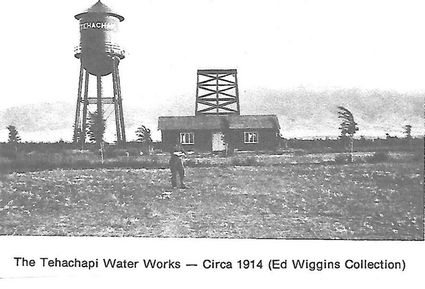We were a tank town!
The Spirit of Tehachapi
I just ran onto a photo of our community water tank from years past; the caption at the bottom says, circa 1914. Circa is a way of saying "about" or "approximately" or "darned if I know!" Close enough. It's from the Ed Wiggins collection and were it not for Ed's saved photos Tehachapi's pictorial history would be sadly lacking. He was the ancestor of Tehachapi's pioneer Wiggins family. He took many, many pictures but did not take this picture of the water tower for Ed was born around 1918!
The tank was later painted silver with black lettering. I like the photo with the trees around the house, bending in the eternal Tehachapi wind. Notice the pear orchard in the background. The tank and building were actually located on the south side of what would some day be the city park between the grammar school and Mojave Street. Also, at that time, Davis Street crossed E Street and ran by the east side of the school into a dead end at the pear orchard. In 1940 that portion of Davis Street was eliminated as a hazard to students who sometimes used the park for projects. We must recall though, that in the old photo the park was yet to be planted. So, the Water Works faced north and overlooked the vacant land that later became the city park.
In 1912 Tehachapi voted bonds in the amount of $1,400 to construct a public water system consisting of wells and pumping plants which furnished an abundant supply of good water. Before that people had their own wells or carried their water. Wooden water mains were installed and not replaced until after the system was ruined in the 1952 quake. There is a relic of those old wooden water mains in the local museum. I often show it to visitors and tell them that when the new water mains were installed the water didn't taste the same. Perhaps my imagination or maybe not.
Sherm Chitwood and his wife, June, lived in the house. It was a funny house that had shingles on its exterior. I recall them being stained dark green. Stained, not painted. He was the first Superintendent of the Water Works. They weren't listed in the phone book as Chitwood but under the Tehachapi Municipal Water Works number. The operators knew that when someone wanted Sherm's house to ring the water company.
According to the writings of Lon Dennison, he generalizes the planting year of the park at "about" 1927. An old time resident and many year grammar school teacher, Gertrude Matthews Phelps, born in 1904, said she remembered when the park was planted but did not specify a year. She doubted that the trees would survive as the watering was done whenever someone remembered to do it. No sprinkler systems then. She sincerely hoped that the young park trees would out live her. They did.
Now known as Philip Marx Central Park people still seek shade and a cool refuge in summer. Out of towners often drive up to our town to escape the scorching desert and San Joaquin Valley temperatures. I noticed recently some of the very old trees were taken down. Those old, old poplar trees had a long run.
After the earthquake my husband returned from the Korean Conflict (or Police Action as it was labled – Heaven forbid they call it a war). We went off to Camp Pendleton and the silver water tank with Tehachapi painted on its side, telling folks what town they were in, went away. Sherm and June Chitwood's green shingle house disappeared, also. No more a tank town.
Still, Tehachapi seems to reach out to people. They say to me, "Oh I just LOVE your small town!" They don't know small towns. A small town, to me, is a community of, perhaps, 600 or at most a few thousand souls. If you can walk down the street and not meet someone you know, then the town is too large. A small town is a place where your kids could play in the street with their friends and then after dinner go out and play some more.
I recall, as an operator on the town's single switchboard, getting a call from a young girl, Sody Hayes. She had gotten home from school and found her mother away. She called the operator and said, "Where's my mother?" Sure enough her mother had left word with the operator to tell her daughter where she was. Sody's still around but is of voting age now.
A small town is when the fire whistle sounds and people call the operator to see where the fire is. As a child, I was often sent to the store to get something my mother needed and then I would say, "Mama said to put it on the bill!" Try that at Walmart!
Actually, "them days are gone forever." It's fun to remember them, though and I notice that the longer the new people from the larger cities live here, they begin to smile and speak to people they don't know. Walking with my husband one day, we both greeted a friendly couple who had given us a enthusiastic hello. After we exchanged a few pleasantries we went on. I said, "Who was that?"
He said, "I don't know, I thought you knew them." I guess that couple thought the same thing.
I guess you could still call us a tank town; the railroad water tank on our main street tells people where they are. Welcome to Tehachapi.





